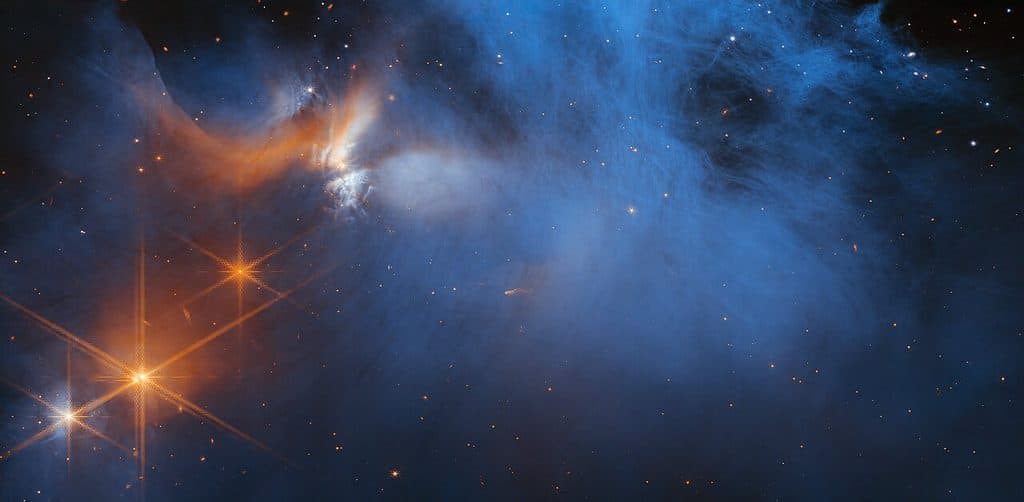
Every planet in the solar system, including Earth, was formed from a swirling disk of gas and dust around the sun. But where exactly do these building blocks come from?
An international team of astronomers has used NASA’s James Webb Space Telescope to take a deep dive into the icy ingredients of the universe, which hold the key to understanding how planets are formed. The team, led by astronomer Melissa McClure of Leiden Observatory in the Netherlands, obtained a comprehensive inventory of the coldest ices measured to date in a molecular cloud, providing new insights into the formation of planets and the presence of life-sustaining molecules.
A new window into some of the murkiest structures in the universe
Molecular clouds form clumps of gas and dust that can stretch over many hundreds of light-years. This interstellar medium contains primordial leftovers from the formation of the galaxy, detritus from stars, and the raw ingredients for future stars and planets. But despite the importance of these molecular clouds, there are still many gaps in our understanding due to their obscure nature.
Dust is very good at absorbing visible light, especially toward the blue end of the spectrum. The cloud’s high density also hampers observations, even when performed with radio waves. Well, this sounds like the perfect job for the James Webb Space Telescope (JWST), which was designed exactly for such situations.
JWST is about 100 times more sensitive than Hubble thanks to its much larger light-collecting mirror. However, the most powerful feature of the JWST is its ability to ‘see’ in mid-infrared and near-infrared, allowing astronomers to peer through dust clouds that would normally obscure stars, planetary systems, and distant galaxies from their prying eyes. JWST is so sensitive it can actually reveal the composition of far-away exoplanets’ atmospheres. It can also look much farther back in time and in much greater detail than any other telescope before it because the most distant (and therefore the earliest) stars and galaxies are redshifted, meaning their light is pushed from optical and ultraviolet into the near-infrared range. There is no instrument other than the JWST that can see the very first galaxies formed in the universe.
For their new study, McClure and colleagues directed JWST’s lens towards Chamaeleon, a very active star-forming region only about 600 light-years away from Earth.
The data revealed the presence of frozen carbon, hydrogen, oxygen, nitrogen, and sulfur. Known as “CHONS”, these elements are considered the most essential ingredients in both planetary atmospheres and molecules like sugars, alcohols, and simple amino acids that are required to sustain life.

The researchers also found the frozen forms of a wide range of molecules, from simple ice like water to more complex organic molecules like carbonyl sulfide, ammonia, methane, and methanol. Some of the icy molecules’ temperatures hovered at around -263 degrees Celsius (-441 degrees Fahrenheit), which is just a few degrees shy of absolute zero, making them the coldest type of ice found thus far.
The study marks the first time that complex organic molecules have been identified in the icy depths of molecular clouds before stars are born. The discovery of complex organic molecules like methanol and potentially ethanol suggests that the many star and planetary systems forming in this particular cloud will inherit molecules in an advanced chemical state, potentially increasing the likelihood of the presence of precursors to prebiotic molecules in planetary systems. This could also mean that precursors to life-sustaining molecules are a common result of star formation, rather than a unique feature of our own solar system, according to Will Rocha, an astronomer at Leiden Observatory.
One of the key challenges that astronomers faced was understanding how much of these CHONS elements are trapped in ices, soot-like materials, or inside rocks. The amount of CHONS in each type of material determines how much of these elements end up in exoplanet atmospheres and how much in their interiors.
“The fact that we haven’t seen all of the CHONS that we expect may indicate that they are locked up in more rocky or sooty materials that we cannot measure,” explained McClure. “This could allow a greater diversity in the bulk composition of terrestrial planets.”
This research is part of the Ice Age project, one of Webb’s 13 Early Release Science programs, designed to showcase the telescope’s capabilities and allow the astronomical community to learn how to best use its instruments. The Ice Age team has already planned further observations and hopes to trace the journey of the ice from formation to the assemblage of icy comets.
“We simply couldn’t have observed these ices without Webb,” said Klaus Pontoppidan, Webb project scientist at the Space Telescope Science Institute in Baltimore. “The ices show up as dips against a continuum of background starlight. In regions that are this cold and dense, much of the light from the background star is blocked, and Webb’s exquisite sensitivity was necessary to detect the starlight and therefore identify the ices in the molecular cloud.”
With this exciting research, the journey to understand the formation of life continues, taking us to the icy depths of space and beyond.
The findings appeared in the journal Nature Astronomy.









